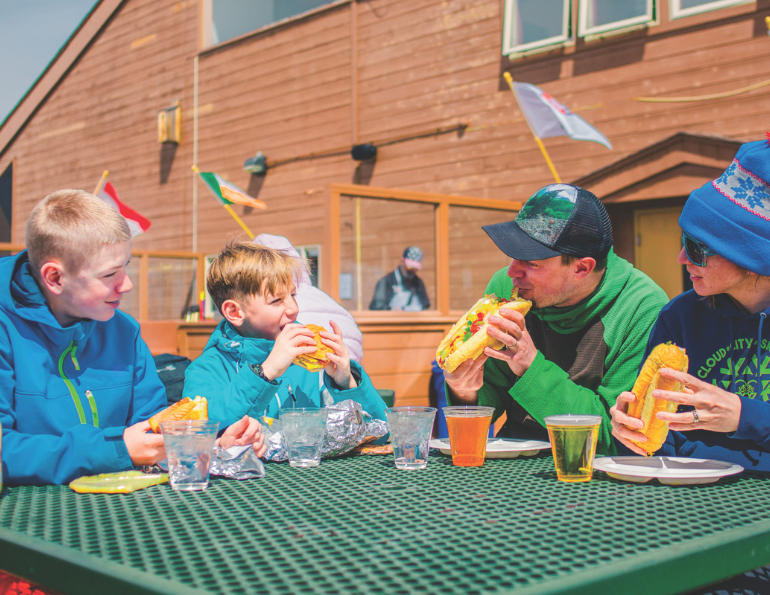At the annual Colorado Ski Country USA meeting in June 2024, members from nearly two dozen ski areas discussed the public’s perception of the ski industry, with many arguing that skiing has never been more affordable. But Nelson Holland, a content creator and new skier who was invited to the meeting to provide an outsider’s perspective, disagreed.
“Honestly, this is all falling on deaf ears,” Holland told the operators in the room. He explained that, as a newcomer, he didn’t want to have to get on a website in advance to figure out what day he can afford to go skiing—nor did he have interest in their season passes because he wasn’t sure if he even liked skiing yet.
The message resonated with Patrick Torsell, senior director of operations and strategy for the nonprofit Ski Cooper. He was in the midst of working with his team to update the ski area’s traditional advance-purchase pricing model for the 2024-25 ski season.
Four months later, pricing was nearly final. Prodded by Ski Cooper’s president and CEO for last-minute feedback or out-of-the-box ideas, the pricing team, inspired by Holland’s comments at the June meeting, took the opportunity to discuss the elephant in the room—their pricing model was contributing to the issue of accessibility.
Twenty-four hours later, the team had switched from its dynamic pricing model to one that offers $45 adult lift tickets Monday through Thursday—and $35 youth tickets seven days a week, including holidays—regardless of whether tickets are purchased in advance online or day-of at the window.
This represented a dramatic price cut from 2023-24, when midweek adult tickets were $65 in advance and $95 at the window. It was a bold move and a huge risk. But the upsides made it a worthwhile leap.
A Change with Two Goals
Breaking down barriers. For frequent skiers and riders, multi-mountain passes like Epic and Ikon offer a good value relative to window ticket prices. However, for those who only ski occasionally or, as Holland pointed out, are new to the sport, the value isn’t there.
“As a content creator or a friend trying to sell skiing to somebody, it’s a lot easier to say ‘[skiing will] cost $150 total,’” Holland tells SAM. “Compared to telling them a lift ticket will be at least $150, then you have to rent gear, and so on.”
Similarly, the complexity of planning a ski trip and the associated costs can be daunting to new skiers, inadvertently discouraging people from getting into the sport. “My first time filling out any of this stuff on the internet,” says Holland, “everything was overwhelming—everything from being on the internet to coming to the base and not knowing where you are.”
“How long have we been saying our biggest problem is beginner conversion and increasing participation numbers?” asks Torsell. “[The industry has] created a model that’s so unfriendly to new skiers that we’re basically putting up all these barriers to entry.”
There are many benefits to the advance purchase/dynamic pricing model, designed to lead people to buy tickets in advance online, such as good deals for people who plan ahead and predictability for operators. But it can confuse and frustrate newcomers who don’t know what they don’t know. Of course, prior to dynamic pricing, ski areas had set pricing for the season, so everyone paid the same. It was uncomplicated for consumers.
Increasing midweek visitation. The Ski Cooper team hoped implementing the new pricing model would not only break down the barriers of cost and complication, but also accomplish the elusive goal of getting more people on the hill midweek.
Ski Cooper’s $30 ticket special on Thursdays during the 2023-24 season served as a litmus test for this new approach. The deal was so popular that some Thursdays neared capacity, while Mondays through Wednesdays were quiet. Theoretically, offering a good price all four midweek days would level out visitation through the entire week.
The Process
The Ski Cooper team determined they could take a chance on the new model due, in part, to the ski area’s lack of debt—if it failed, they could return to the original model without much of an impact. Not every ski area has that luxury, of course.
After the idea was pitched, Torsell created an Excel spreadsheet that took different variables into account, including targeted yield per visit and the required day pass price to achieve that yield. It also took comp and season pass tickets, fixed operation costs, and an estimated visitor increase into account.
“I plugged in a few numbers, and it spat out a number that was pretty close to 45,” Torsell recalls. “I took it back to the team and told them I thought this number would allow us to achieve our financial goals but still be low enough to be disruptive and attractive.”
The overwhelming number of guests that showed up on Thursdays during the prior season proved that $30 was lower than necessary, but it also gave the team a baseline for estimating the visitation numbers used to calculate their new midweek ticket prices, which helped validate the $45 rate.
 To make skiing and riding both accessible and affordable, Ski Cooper set a low daily ticket rate for kids.
To make skiing and riding both accessible and affordable, Ski Cooper set a low daily ticket rate for kids.
The Rollout
When Ski Cooper’s core staff were told of the change at a staff meeting just after the final decision was made, the general consensus was that despite it being a risk, it was an exciting venture that could accomplish their overall mission of getting more skiers on snow.
The public shared that optimism. During Ski Cooper’s annual community meeting in the fall, which is open to the public but geared toward residents of Lake County (which owns Ski Cooper’s fixed assets; an independent 501(c)4 with a long-term lease operates the ski area), the announcement garnered a round of applause. Some locals shared concerns about overcrowding, but leadership didn’t foresee that being an issue.
The marketing team also anticipated the announcement would create a buzz within the ski community. Marketing director Dana Johnson crafted a PR plan. The rollout started with a press release that declared “Cooper bucks the trend with the lowest day pass pricing even at the ticket window,” which was picked up by more than a dozen publications, including the New York Times, Powder, the Denver Post, and SAM magazine.
From there, the story spread like wildfire and put the lesser-known Ski Cooper on the national map.
Initial Results
Increased revenue and visitation. As of mid-March, the financial results of the pricing strategy were promising. Considering only Monday through Wednesday (excluding vacation days), ticket revenue was up 38 percent year-over-year, visitation was up 32 percent, and overall gross revenue was up 25 percent. As expected, ticket yield was down on these days, but that’s offset by the increased visitation.
An unanticipated result was a significant boost in ski school and rentals, which contributed to the jump in gross revenue: ski school was up 44 percent, and rentals were up 54 percent, Monday-Wednesday. For Torsell, this is proof that the new model is accomplishing the goal of giving new skiers access to the sport.
Food pricing. Of course, the cost of lift tickets isn’t the only thing that makes skiing expensive. At most ski areas, you can’t get a basket of fries and a few chicken fingers for less than $20. So, Ski Cooper dropped some of its food and beverage prices, too—a cheeseburger this season was $10 (down from $12 last season) and a cheese pizza was $5 (down from $10) at the base area cafeteria.
While Torsell admits it’s a bit early to draw a conclusion about the long-term impact of lower food and beverage pricing, the cafeteria was achieving its budgeted yield, confirming that an increased sales volume again has offset the price cuts.
Staffing, rentals, and infrastructure. Even with the 32 percent increase in visitation, Ski Cooper isn’t even close to reaching capacity midweek. Lift lines don’t exist, there are plenty of rentals in the fleet, and staffing has remained mostly status quo.
“Historically, [Monday through Wednesday] were ghost town days here,” says Torsell. “It takes a baseline number of people to run this place whether there’s one person or 5,000 people skiing. Since we’ve been able to increase visitation and everything that comes with that without having to increase staffing, we’re seeing better performance.”
Challenges. Despite the initial results and rosy outlook, Torsell acknowledges that dynamic pricing has benefits that the new model lacks.
“We went from having probably around 80 percent of our day tickets being purchased in advance to maybe 25 percent,” he says. “That’s made it more difficult for us to forecast visitation.”
In the short term, predictability is important when considering the required staff for a given day and how much food and retail inventory is needed.
The team is still pushing skiers to purchase in advance, citing simplicity and shorter wait times as advantages. Regardless, these challenges are surmountable and not impactful enough to reconsider the new model.
A Replicable Model
According to Torsell, a similar pricing model as Ski Cooper’s may not work for resorts already struggling to manage capacity or mega-resorts focused on destination skiers and season passes, but could be feasible at other small- and medium-size ski areas with local and regional clientele, especially those looking to increase midweek business.
“I see this being a great model for ski areas who have the opportunity to create new skiers and to bring back lapsed skiers,” he says. “But this model is good not just for those people, it’s also for the occasional skier who doesn’t need 5,500 acres at Vail and is perfectly happy to ski twice a year on 500 acres at Ski Cooper.”
That said, even large ski areas can offer affordable ticket prices at the window and still enjoy financial success.
Another Model
Case in point: Idaho’s Bogus Basin. The 2,600-acre nonprofit ski area sells lift tickets that top out at less than $90. Due to its proximity to the densely populated city of Boise, weather and conditions rather than the day of the week often dictate how busy it is. That makes it difficult to offer discounted day tickets midweek. But that proximity provides other ways to create opportunities to ski for less, like time-limited lift tickets and passes.
“What we’ve done to make skiing more affordable is create times we can bring people in without overrunning the ski area,” says Bogus Basin general manager Brad Wilson. “On Saturdays, we’re busy like everyone else first thing in the morning. But by mid-afternoon, people start leaving. So, we have both a season pass and day tickets that are valid for later in the day, seven days a week.”
Like Ski Cooper, the late-day tickets are a flat rate, regardless of how, where, and when they’re purchased. For $39, skiers and riders can hop on lifts from 3-10 p.m. A 6-10 p.m. ticket is just $19. Bogus Basin has achieved record or near record revenue and visitation in recent years, and Wilson says the ticket model has contributed to that.
More folks, more dough. Regardless of how it’s done, the point remains the same: simplifying the lift ticket pricing model and offering affordable passes benefits the entire ski industry.
Torsell tends to see things from “30,000 feet,” as he puts it, and suggests that if more ski areas used Ski Cooper’s ticket model, it could help make skiing more accessible to more people through affordable pricing and a simplified process—while still generating strong financial performance.






